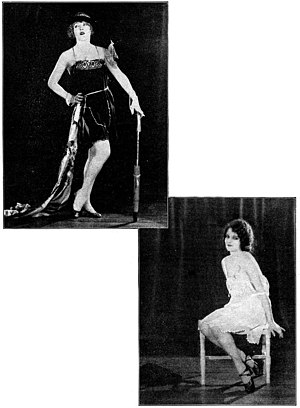The
Crepe de chene
Revolution
By Helen Lee

Black negligée is piquant—and as worn by Mae Murray, at the left, is more propaganda for crepe de chene. The young lady below is Peggy Shaw.
Back in the days when we were young and innocent and never went to the movies, all little girls and boys thought that an envelope was something you sent a letter in and that a combination was a salad made of cucumbers and tomatoes.
Also it was polite to refer to lingerie as "unmentionables," although, strictly speaking, it should have been "unpronounceables."
It was generally conceded that you couldn't beat a good, high-necked and long-sleeved flannelette nightgown for durability and warmth. You were also supposed to be risking a bad case of pneumonia or a severe attack of quinsy sorethroat when you ventured forth in less than two flannel petticoats. Nightgowns or petticoats with ribbons on them were thought to be an infallible sign of a wayward disposition and a tendency for the primrose path.
The first daring pioneers who ventured into pink crepe de chine were terribly talked about when the neighbors sighted the filmy garments on the clothesline. Clergymen were immediately reminded of the Fall of Rome. Nowadays the girls who wears pink crepe de chine is considered just too naive and unsophisticated for words.
Gloria and the Flannelette Market
But, so far, no viewer-with-alarm has yet blamed the movies for the terrible slump in the flannelette
